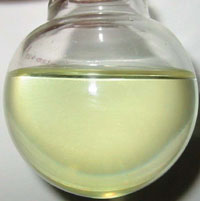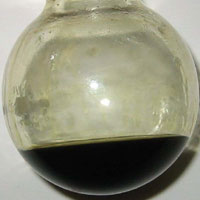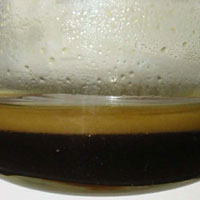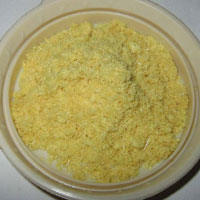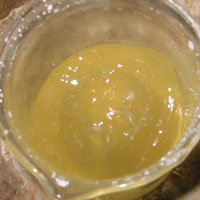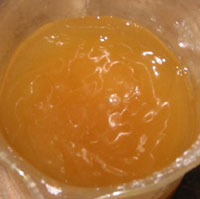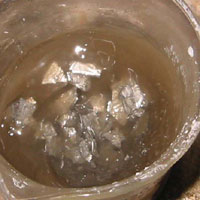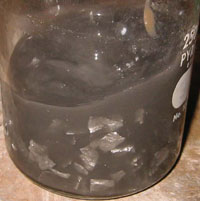This synthesis of Indanylamphetamine [IAP, 1-(5-Indanyl)-2-aminopropane] was loosely based on the synthesis of IAP earlier posted by Rhodium, but quite a few changes were made to the final steps due to LAH not being at hand at the moment.
All the steps and intermediates has been documented in this photo-essay, and by clicking any of the images, you can access them in full size. Enjoy.
Synthesis of Indane-5-carboxaldehyde
30 grams (253.8 mmol) of indane was dissolved in 300 ml DCM in a 1 L RBF in an ice bath. 42 ml (72.3 g, 381 mmol) of TiCl4 was added. This stuff is super nasty. It is a fuming liquid with a vapor pressure that will push fluid out of a pipet in a smoking, lung burning stream when trying to transfer it. A syringe and fume hood should be used if you are not an idiot like this experimenter. The color of the solution changed from clear to slightly brown. 29.2 grams (253.8 mmol) of dichloromethyl methyl ether, which is also a nasty lung burning liquid, was added with an addition funnel over a time period of about 15 minutes. The reaction is exothermic so care should be taken to not add it too fast. The solution became a deep red color. After 30 minutes the ice bath was removed and 375 ml ice-cold water was added at once. The vigorous reaction that occurred caused an untrivial amount of the solution to spew out of the top of the flask. The contents of the flask were transferred to a 1 L sep-funnel. Then the aqueous layer was discarded and the organic layer was washed 3x300 ml water. During the first water wash, the color of the organic layer turned from deep red to light brown, maybe as the product was uncomplexed from the Ti atom. Then the organic layer was washed 3x150 ml 3M HCl and 2x150 ml brine. Then the DCM was removed at the rotovap and the brown residue distilled at ~0.2 mmHg (the vac pulls MDP2P over at 100°C). The first fraction came over from 50-57°C, was water white, weighed 2.9 grams, and smelled exactly like indane. The next fraction came over from 100-101°C, was light yellow, smelled sweeter than the first, and weighed 9.8 grams, corresponding to a whopping yield of 26%. The yield was so low because a good portion of the rxn mix was lost during the water-quenching step. Also, a previous trial using SnCl4 rather than TiCl4 gave a better yield, but still not 98%.
Synthesis of 5-indanyl-2-nitropropene
9.8 g of indane-5-carboxaldehyde was added to a 1 liter flask along with 75ml EtNO2. A smaller flask would have been used, but the experimenter only has 50ml, 1000ml, and 5000ml heating mantles, and he didn’t feel like setting up an oil bath. Stirring was started, and the heating mantle set on 40 Volts. Ammonium acetate was dried in a vacuum desiccator and ground to a fine powder with a mortar and pestle. 3.0 g were added and a reflux condenser attached. The color of the flask contents was initially a light yellow with a hint of green. Within 10 minutes of refluxing, the color had already changed to a darker, urine yellow. Over the next 4 hrs., the color progressively became a darker orange/brown. At the end of 4 hrs, the excess EtNO2 was rotovapped off, leaving behind a dark brown oil. This oil was dissolved in 100ml ether, washed 3 times with 50ml water and twice with 50ml brine. A small chunk of anhydrous MgSO4 (baked Epsom salts) was added to dry any last traces of water and the ether was rotovapped off.
Some methanol was brought to a boil, and just enough was added to the flask with the residue to make everything go into a dark brown solution. Approximately 10ml was used. Upon pouring the hot methanolic solution into a beaker with cold sides, the methanol became cloudy with what appeared to be the nitropropene oiling out. It eventually formed a light tan colored layer on top of the darker methanol layer. The beaker was placed in the freezer.
The contents of the beaker were filtered, the crystals put back into the beaker, fresh cold methanol was added, the crystals were stirred for a while, and then filtered, air dried, and dried in a vacuum desiccator. The final weight was 4.9 g.
Preparation of indanylisopropylamine (indanylamphetamine)
Reduction of the nitrostyrene will yield the amphetamine. LAH reductions were attempted but failed for various reasons, including wet THF and inactive LAH. Instead of waiting for more LAH to arrive, the experimenter decided to use a different method of reduction, NaBH4 to reduce the double bond followed by Al/Hg to reduce the nitro group. The procedure followed was one earlier used in DrGonzo's synthesis of DOB.
3.8 grams of the nitropropene was dissolved in 100 ml MeOH in a 300 ml beaker with stirring. 0.9 grams NaBH4 was added a spatula tip full at a time over a period of about 20 minutes.
Then 20 ml of 20% HCl was added. Then a spatula tip full of Hg(SCN)2 was added. Then aluminum foil was torn to small pieces and gradually added, approximately 5 grams over 45 minutes time period. At first, little reaction was noted, but as the temperature increased, the reaction accelerated.
At about the 1-hour point, the reaction quickly took off and became exothermic. Once it had subsided some, more aluminum was added (a total of about 10 grams for the whole rxn.). The solution was left to stir overnight. The next morning MeOH was added to dilute the nasty sludge. The MeOH was decanted away from the sludge and fresh MeOH added to it and swirled. This was then decanted away from the sludge and the process repeated once more. The sludge was discarded.
The MeOH extracts were combined and MeOH and water was removed at the rotovap. 300 ml 30% NaOH was added to the sludge and a mostly homogenous grey solution resulted (much like a MM Al/Hg reduction workup). This was extracted with 3x40 ml of ether. The ether layers were combined and washed twice with water, then extracted with 3x40 ml of 5% HCl. The aqueous layer was basified with saturated NaOH until pH ~ 14. This was extracted with 3x30 ml DCM. The DCM was washed with water twice, brine once, and dried with a piece of MgSO4. The DCM was removed at the rotovap to leave about 1 ml of amber freebase oil in the flask.
The oil was dissolved in 15 ml cold, dry ether. The ether was gassed with HCl to precipitate the hydrochloride salt of indanylamphetamine.
The product was filtered, rinsed with a small amount of ether, dried, and weighed 1.2 grams.
This product was then recrystallized from a minimum amount of boiling isopropanol.
